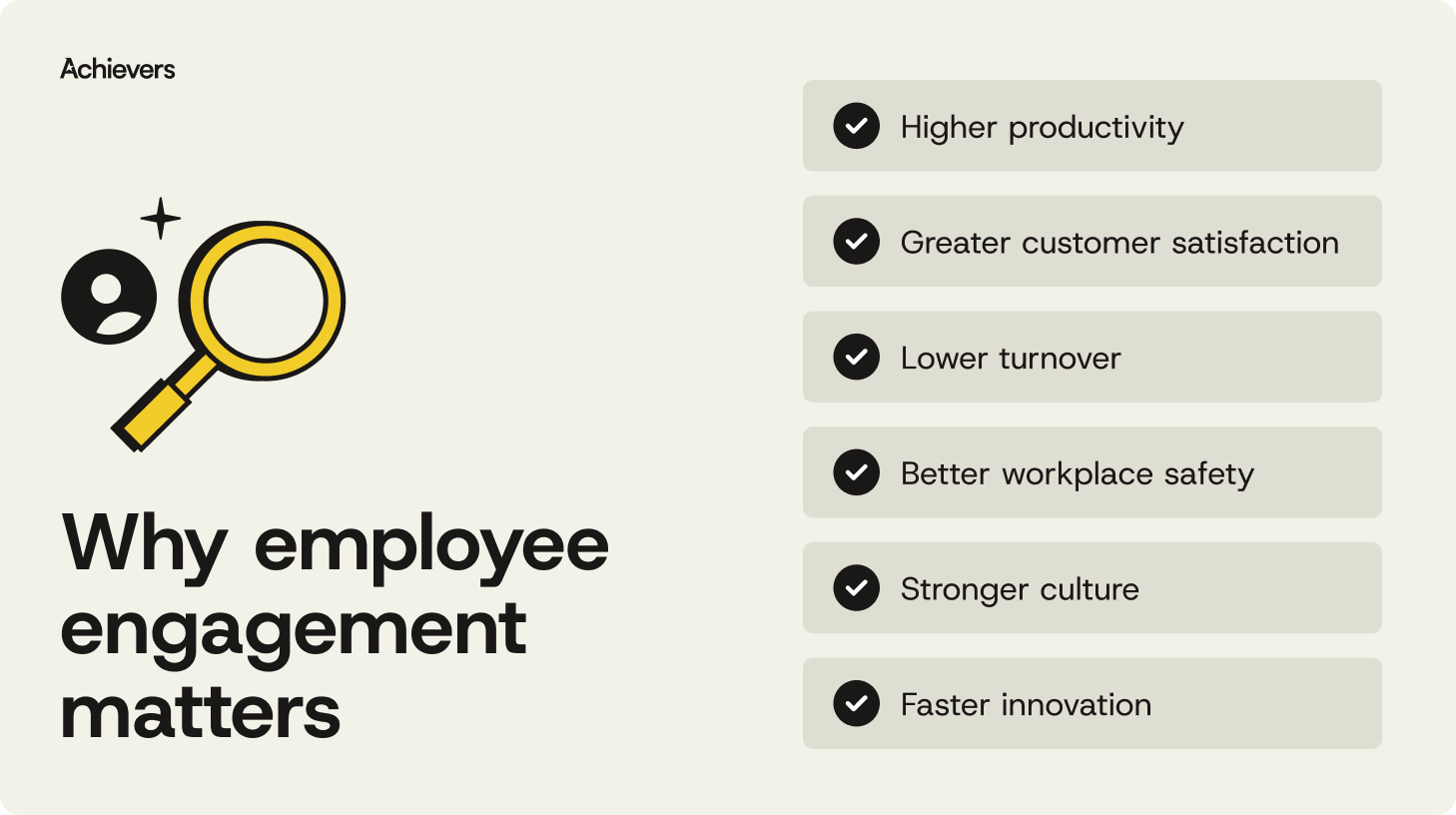Table of contents
Employee engagement gets thrown around a lot — but at its core, it’s simple. It’s about how connected people feel to their work, their team, and the bigger picture. When that connection clicks, people care more, contribute more, and stay longer. When it doesn’t… well, you can feel it.
At the start of 2024, 41% of employees planned to job hunt — and another 24% were undecided, according to Achievers’ Engagement and Retention Report. That’s two-thirds of the workforce already eyeing the door. If that doesn’t signal a need for change, nothing will.
The truth is, engagement isn’t something you can fix with free snacks or a quarterly survey. It takes intention — and the right systems to back it up. This guide walks through what really drives engagement, how to measure it, and how the smartest companies are scaling it through connection, recognition, and culture that truly resonates.
Why employee engagement matters
It’s easy to treat engagement as optional. But the reality? It’s one of the most reliable indicators of whether your business is set up to succeed or scramble.
When engagement is low, you feel it across the board: performance dips, customer experience suffers, and turnover rises. When it’s high, everything works better — from productivity to innovation.

Here’s what you’re really investing in when you invest in engagement:
- Higher productivity: Engaged employees don’t just get more done — they bring energy and purpose to the work. That shows up in faster execution, sharper focus, and stronger outcomes.
- Greater customer satisfaction: People who feel connected to their work are more likely to go the extra mile for customers. That care and commitment ripple outward — straight to your brand experience.
- Lower turnover: When employees feel seen, valued, and supported, they’re far more likely to stay. Engagement is one of the strongest predictors of retention — and it costs a lot less than replacing top talent.
- Better workplace safety: A psychologically safe workplace is an engaged one. When people feel safe speaking up, asking questions, or owning mistakes, the whole organization runs more smoothly — and more safely.
- Stronger culture: Engagement fuels culture — not the other way around. Recognizing the right behaviors, building trust, and reinforcing shared goals all help shape a culture people want to be part of.
- Faster innovation: People do their best thinking when they care about the outcome. Engaged teams are more likely to share ideas, experiment, and collaborate — turning good intentions into big ideas.
The real power of engagement shows up in the little things. People pitch in without being asked, go further than the job description, and care about the end result — because it feels like their work matters.
7 pillars of employee engagement
Engagement doesn’t happen by accident, and it’s not about guessing what might make people happy. It’s about building the right foundation. These pillars are what actually drive employee engagement today:
- Clear goals and expectations: Employees want to know where they’re going and what success looks like. Clarity gives people confidence — and makes it easier for teams to stay aligned and accountable.
- Ongoing feedback and communication: Engagement thrives on dialogue, not monologues. Frequent, two-way communication helps employees feel heard, supported, and in the loop — not left guessing.
- Recognition and appreciation: Recognition isn’t just a feel-good moment. When it’s specific, timely, and tied to values, it reinforces the behaviors that matter — and makes people feel truly seen.
- Opportunities for growth and development: Stagnation is the enemy of engagement. Employees are more invested when they can see a future — with access to learning, stretch projects, and clear career paths.
- Psychological safety and inclusion: When people feel safe to speak up, ask questions, and show up as themselves, engagement gets stronger. And it goes hand in hand with balance. Supporting work-life boundaries shows employees that their well-being matters, and that they’re trusted to manage their time and energy in a way that works for them.
- A sense of purpose and impact: People want to know their work means something. Connecting day-to-day tasks to bigger goals helps employees feel like they’re part of something that matters.
- Strong relationships with managers and peers: Engagement is personal — and relational. Trust, support, and meaningful connections at work have a huge impact on how committed people feel to the organization.
How to measure employee engagement: A guide to smarter action
If you want to improve engagement, you have to do more than measure it. You have to mean it. Because no matter how pretty your engagement survey looks, it won’t move the needle unless it’s backed by action.
Here’s how you can get it right:
- Listen often — and on purpose: The annual engagement survey? It’s officially outdated. Today’s platforms track how people are feeling in real time — across milestones, moments, and manager relationships — so leaders can act before disengagement spreads.
- Make check-ins count: One-on-ones aren’t status updates. Done right, they’re trust-builders — regular touchpoints where employees feel heard, supported, and a little more human at work.
- Create space for honest feedback: Focus groups and town halls help fill in the blanks your dashboards can’t. They surface the “why” behind the numbers — and give employees a say in shaping what comes next.
- Track recognition like it matters (because it does): Recognition is more than a feel-good moment. It’s a window into what behaviors are being celebrated — and where teams might be missing the mark on values, culture, or connection.
- Pay attention to patterns: Engagement shows up in behavior. If people stop participating, start burning out, or quietly check out, the data will tell you. The question is: will you notice it in time?
The recognition effect — why it drives engagement faster
Recognition gets written off as a “nice gesture” way too often. But the data tells a different story. According to Achievers Workforce Institute, employees who get recognized in a meaningful way at least monthly are 6x more likely to recommend their company as a great place to work.
That’s a big lift — from something that takes just a few minutes, but makes people feel seen, valued, and connected to their purpose.
That’s where Achievers comes in. Our employee recognition platform is built to make recognition more than a feel-good moment — it turns it into a habit that fuels engagement, culture, and performance. Here’s how:
- Recognition fits right into the flow of work: With integrations into the tools your teams already use, it’s easy to send recognition in real time — no extra tabs or awkward workflows.
- Backed by behavioral science: Every part of the platform is designed around what actually drives people — so recognition isn’t just frequent, it’s meaningful and aligned to the right behaviors.
- Rewards that feel personal, not uniform: With a global rewards marketplace that spans experiences, donations, gift cards, and more — across 190+ countries — employees can choose what matters to them.
- Insights leaders can act on: Real-time dashboards make it easy to spot trends, flag gaps, and understand how recognition is driving engagement — so managers and leaders can act, not just observe.
- Tools that help build a more inclusive culture: With features like the Inclusion Coach and always-on feedback, we help organizations make sure every voice is heard — and every person feels valued.
Build an employee engagement strategy that scales
At the end of the day, employee engagement doesn’t just happen — you build it. Through recognition, connection, and continuous measurement, you shape the workplace where people want to show up, contribute, and stay.
But doing that at scale is a different challenge. As organizations grow, culture can get diluted, tools become disjointed, and engagement strategies start to lose momentum. That’s where a purpose-built platform makes a real difference.
Achievers is designed to keep recognition flowing, feedback constant, and insights actionable. Every interaction is built to feel personal, no matter how large or global your team is. It’s not about adding more tools. It’s about making engagement part of how your organization works — every day.
If you’re ready for a better approach to employee engagement, we’re ready to help you build it.



